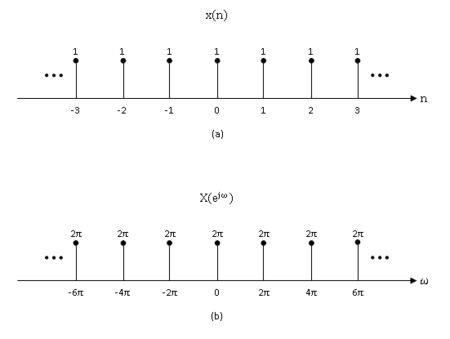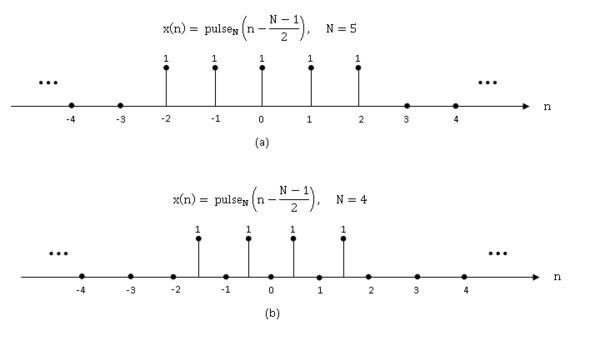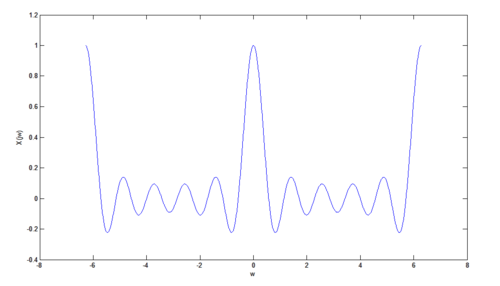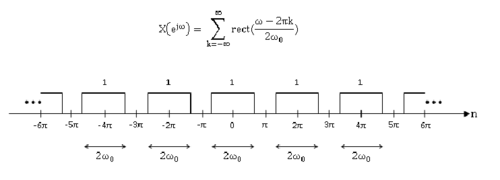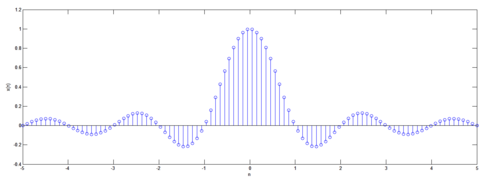- ↳ Topic 4: Discrete Parameter Signals and Systems
- ↳ Discrete Transforms
- ↳ Sampling and Scanning
- ↳ 2-D Filters
- ↳ 2-D Random Processes
- ↳ Filtered Random Processes
- ↳ Eigen-Signal Analysis and Examples
- ↳ Supplementary: Proof of Wiener-Khintchine Theorem
The Bouman Lectures on Image Processing
A Slecture by Maliha Hossain
Subtopic 1: Discrete Transforms
© 2013
Contents
- 1 Excerpt from Prof. Bouman's Lecture
Excerpt from Prof. Bouman's Lecture
Discrete Time Fourier Transform (DTFT)
The DTFT is the analogous transform for discrete time signals as the CTFT is for continuous time signals. Let $ x(n) $ be a discrete time signal. Then, its DTFT, $ X(e^{j\omega}) $ is given by
$ X(e^{j\omega}) = \sum_{n = -\infty}^{\infty}x(n)e^{-j\omega n} $
$ x(n) $ can be recovered using the inverse DTFT
$ x(n) = \frac{1}{2\pi}\int_{-\pi}^{\pi}X(e^{j\omega})e^{j\omega n} $
Note that the domain of the DTFT is continuous over (-∞,∞). The DTFT must not be confused with the Discrete Fourier Transform (DFT) which is a transform on a finite length sequence whereas the DTFT is a transform from -∞ to ∞.
Also note that the DTFT is periodic with period $ 2\pi $. Therefore,
$ X(e^{j\omega}) = X(e^{j\omega})\quad \forall \; \omega $
If you know the DTFT of a signal over some interval of length $ 2\pi $, then you know it for all $ \omega $. The periodicity of the DTFT means that functions such as rect$ (\omega) $ are not valid DTFT's.
Some Useful Discrete Time Functions and Transform Pairs
Some of the functions that appear in discrete time analysis will be covered here. For more resources on the DTFT and its properties, you may wish to refer to Rhea's table of formulas concerning the DTFT.
Constant Functions
Since the DTFT is a linear transform, I will only cover the simplest case when $ x(n) = 1 $. The DTFT of a constant function produces a pulse train that is periodic with period $ 2\pi $.
$ \begin{align} x(n) &= 1 \\ \Rightarrow X(e^{j\omega}) &= 2\pi\sum_{k=-\infty}^{\infty}\delta(\omega-2\pi k) \end{align} $
It is much simpler to show that the IDTFT of the pulse train is one rather than to show that the DTFT of one is the pulse train.
$ x(n) = \frac{1}{2\pi}\int_{-\pi}^{pi} 2\pi\sum_{k=-\infty}^{\infty}\delta(\omega-2\pi k) $
Since there is only one impulse from the sequence that is present in the $ (-\pi,\pi) $ interval, only one term from the sequence is relevant to the integral, the $ k=0 $ term.
$ x(n) = \frac{1}{2\pi}\int_{-\pi}^{\pi} 2\pi \delta(\omega) = 1_{ \quad \blacksquare} $
The Step Function
The step function is equal to one for all n greater than or equal to zero and zero otherwise.
$ \begin{align} x(n) = u(n) &= \begin{cases} 1 & n\geq 0 \\ 0 & n< 0 \end{cases} \\ \Rightarrow X(e^{j\omega}) &= \frac{1}{1-e^{-j\omega}}+\pi\sum_{k=-\infty}^{\infty}\delta(\omega-2\pi k) \end{align} $
The Delta Function
Recall that in continuous time, the delta function $ \delta(t) $ is not really a function. It might be more accurate to think of it as an operator. In discrete time however, it is much simpler to describe a delta. It is simply a function which equals 1 when $ n=0 $ and 0 everywhere else.
$ \begin{align} x(n) = \delta(n) &= \begin{cases} 1 & n = 0 \\ 0 & n \neq 0 \end{cases} \\ \Rightarrow X(e^{j\omega}) &= 1 \end{align} $
This result makes sense because in the delta function is contains components at every frequency, each of which have the identical amplitude and phase.
Pulse
A pulse of length N that starts at $ N = 0 $ is given by
$ \begin{align} x(n) &= \mbox{pulse}_N(n)\triangleq u(n) - u(n-N) \\ \Rightarrow X(e^{j\omega}) &= \mbox{psinc}N(\omega)e^{-j\omega\frac{N-1}{2}} \end{align} $
where psinc is the periodic sinc function.
A pulse of length 5 is shown in figure 2. Note that the pulse stops after $ n=N-1 = 4 $. You can also think of the pulse as a shifted rect.
When the length of the pulse is an odd number, such as the case depicted in figure 2, the power of the exponent in the Fourier transform is a whole number and the periodic sinc has period $ 2\pi $. It is possible to center the pulse about $ n=0 $ and have each impulse aligned with an integer value on the $ n $-axis. This is shown in figure 3(a).
If however, N is even such as in figure 3(b), it is not possible to both center the pulse at $ n=0 $ and align individual impulses with integers. Notice that the power of the exponent in the Fourier transform is a fraction. The psinc function is periodic with period $ 4\pi $ so it cannot be a valid DTFT. A phase term $ e^{-j\omega 1/2} $ must be factored in to correct this issue. In the time domain, this corresponds to a time shift of $ 1/2 $ units (from the time shift property of the DTFT). Because of the half sample delay, the resulting product is periodic with period $ 2\pi $.
Periodic Sinc
The psinc or the periodic sinc function is given by
$ \mbox{psinc}_N(\omega) \triangleq \frac{\sin(\omega N/2)}{\sin(\omega/2)} $
The above function is periodic with period $ 2\pi $ when N is odd. It is periodic with period $ 4\pi $ when N is even. You can fix this issue with by introducing a phase term which corresponds to a half sample delay in the time domain (see above). As explained previously, a psinc function in the frequency domain is the DTFT of a shifted pulse centered about $ n=0 $. In other words, it is the DTFT of a rect function.
Periodic Rect
The periodic rect or prect function is given by
$ \mbox{prect}_{2\omega_0}(\omega) \triangleq \sum_{k=-\infty}^{\infty}\mbox{rect}(\frac{\omega-2\pi k}{2\omega_0}) $
the $ \mbox{prect}_{2\omega o} $ function has period $ 2\pi $ so it can be a valid DTFT. Each rect has a $ 2\omega_0 $ wide support. The prect function is basically the frequency response of an ideal digital low pass filter.
If
$ X(e^{j\omega}) = \mbox{prect}_{2\omega_0}(\omega) $
then
$ x(n) = \frac{\omega_0}{\pi}\mbox{sinc}(\frac{\omega_0n}{\pi}) $
So if you were to build a low pass filter, its impulse response would be a sampled sinc in time as shown in figure 6. The sampling period $ T $ is given by
$ T=\frac{\omega_0}{\pi} $
for a low pass filter, the cutoff frequency $ \omega_o $ must be less that $ \pi $ (see figure 5). Therefore, $ T<1 $.
An interesting case is when $ T=1 $. Except for the $ n=0 $ case where $ x(n) = 1 $, all the samples would coincide with the function's zero-crossings and you would end up with a discrete time delta function. In the frequency domain, you would have that $ \omega_0=\pi $. All the individual rects of the DTFT would be back to back so essentially the DTFT would be equal to one everywhere. This is of course what you would expect to be the DTFT of an discrete time delta function.
Discrete Space Fourier Transform and Properties
The Discrete Space Fourier Transform (DSFT) is simply the two dimensional extension of the DTFT. For a discrete time function $ f $ in $ m $ and $ n $, the DSFT $ F(e^{j\mu},e^{j\nu}) $ is given by
$ F(e^{j\mu},e^{j\nu})=\sum_{n=-\infty}^{\infty} \sum_{m=-\infty}^{\infty} f(m,n)e^{-j(\mu m+\nu n)} $
The inverse of the transform is given by
$ f(m,n)=\frac{1}{4\pi^2}\int_{-\pi}^{\pi}\int_{-\pi}^{\pi}F(e^{j\mu})(e^{j\nu})e^{j(\mu m+\nu n)}d\mu d\nu $
Note that the DSFT is a two dimensional continuous periodic function with period $ 2\pi $ in along both the $ \mu $ and $ \nu $ axes. Therefore
$ F(e^{j(\mu+2\pi)},e^{j(\nu+2\pi)})=F(e^{j\mu},e^{j\nu}) $
2-D Z-Transform
Relationship between Fourier and Z-Transforms
References
- C. A. Bouman. ECE 637. Class Lecture. Digital Image Processing I. Faculty of Electrical Engineering, Purdue University. Spring 2013.
Questions and comments
If you have any questions, comments, etc. please post them on this page
Back to the "Bouman Lectures on Image Processing" by Maliha Hossain

